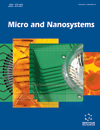- Home
- A-Z Publications
- Micro and Nanosystems
- Previous Issues
- Volume 5, Issue 3, 2013
Micro and Nanosystems - Volume 5, Issue 3, 2013
Volume 5, Issue 3, 2013
-
-
Human Islet Transplantation: Current Status and Future Direction
More LessAuthors: James J. McGarrigle and Jose OberholzerThroughout the past four decades, many inroads have been made in islet transplantation, so much so that this treatment is now seen as a viable therapeutic option for an increasing number of Type 1 diabetic patients. Islet transplantation not only provides initial insulin independence for selected Type 1 diabetic patients but also delivers long-term graft function and symptomatic benefit in terms of avoidance of severe hyp Read More
-
-
-
Microencapsulation for Human Islet Transplantation
More LessAuthors: Bernard E. Tuch and Vijayaganapathy VaithilingamEncapsulation of islets is a promising strategy to deliver a cell therapy for treatment of type 1 diabetes without the need for anti-rejection drugs. The most common form of encapsulation is the microcapsule, which is made from sodium alginate, and is made robust by brief exposure to either Ca2+ or Ba2+. Transplantation of encapsulated human islets into diabetic immunodeficient mice results in rapid normalization of blood Read More
-
-
-
Current Status on Immunoprotection of Transplanted Islets: Focus on Islet Microencapsulation
More LessBy Igor LacíkThis minireview focuses on recent developments in the field of islet microencapsulation as one of the strategies for immunoprotection of transplanted insulin-producing cells for future diabetes treatment. A growing number of peerreviewed publications and reviews in the last few years demonstrate both the progress and strong motivation to identify safe and functional biomaterials. This minireview is primarily based on Read More
-
-
-
Biocompatibility and Biotolerability Assessment of Microspheres Using a Whole Blood Model
More LessAuthors: Anne Mari Rokstad, Berit Strand, Terje Espevik and Tom Eirik MollnesThe whole blood model is a powerful method to determine the immediate inflammatory reactions towards foreign objects in general. This review focuses on the use of a lepirudin based whole blood model for evaluating microspheres relevant in cell transplantation applications. This whole blood model can be regarded as a holistic model with readouts from cross-talks between leukocytes, complement, most of the coagulati Read More
-
-
-
Transplantation of Pancreatic Islets Immobilized in Alginate-Based Microcapsules: From Animal Studies to Clinical Trials
More LessMicroencapsulated islet transplantation has been investigated for over three decades in an attempt to eliminate the hostile effects of long-term immunosuppressant usage and improve islet engraftment in patients suffering from Type 1 Diabetes Mellitus (T1DM). Once feasibility of the islet encapsulation process was confirmed, the biocompatibility and survival of microencapsulated islets were directly tested in different ani Read More
-
-
-
Microencapsulation: The Emerging Role of Microfluidics
More LessAuthors: Sameer Tendulkar, Melur K. Ramasubramanian and Emmanuel C. OparaThe technique of microencapsulation was introduced nearly eighty years ago and its potential application in cell therapy was described almost fifty years later. The technique offers a wide range of applications in both industrial products and personalized medicine. The potential application of the technique in pancreatic islet immunoisolation prior to transplantation was first described in 1980 with the resulting construct termed as Read More
-
-
-
Microfluidic Control of Hypoxia Aids Investigations of Islet Pathophysiology
More LessAuthors: Joe F. Lo, Yong Wang, Jose Oberholzer and David T. EddingtonHypoxia is a prevalent factor regulating numerous biological processes; and of specific interest here, hypoxia is a complication in clinical procedures such as islet transplantation. Recently, temporal oscillations between hypoxia and normoxia, termed intermittent hypoxia (IH), have shown “preconditioning” benefits to pancreatic islets [1-3]. In islet physiology, effects of static and transient hypoxia have not been well- Read More
-
-
-
Application of Microfluidic Technology for Studying Islet Physiology and Pathophysiology
More LessThis review outlines the current status of microfluidic devices used to study the physiology and pathophysiology of pancreatic islets of Langerhans, mainly focusing on the design features and specialized applications of existing microfluidic devices, as well as their advantages and limitations. This review then briefly concludes by describing future perspectives on ways to improve and implement microfluidic technology for islet study.
-
-
-
Application of in vivo Magnetic Resonance Imaging for Islet Transplantation
More LessAuthors: Ping Wang and Anna MoorePancreatic islet transplantation is a promising cure for restoring normoglycemia in diabetic patients. A noninvasive, in vivo approach that could monitor survival of islet grafts is critically needed in clinic. Here we provide a concise overview of the most recent advances in magnetic resonance (MR) imaging of islet transplantation with emphasis on 1) 1H MRI tracking of transplanted islets, 2) 19F MR imaging of islet grafts, 3) ther Read More
-
-
-
PMMA Microfluidic Chips Made by Hot Embossing/Bonding for Optimizing the Flow in Electrophoresis Separation
More LessAuthors: Xueye Chen and Hong ZengTo improve the stability of electrophoresis separation by adding samples at one time, two PMMA microfluidic chips with different configurations were made by hot embossing/bonding method. The reason of bad peak repetition during continuous electrophoresis separation in the double-T microfluidic chip has been analyzed, and a Y-T combination structure has been put forward. Based on the result of the computational flui Read More
-
Most Read This Month
Article
content/journals/mns
Journal
10
5
false
en


